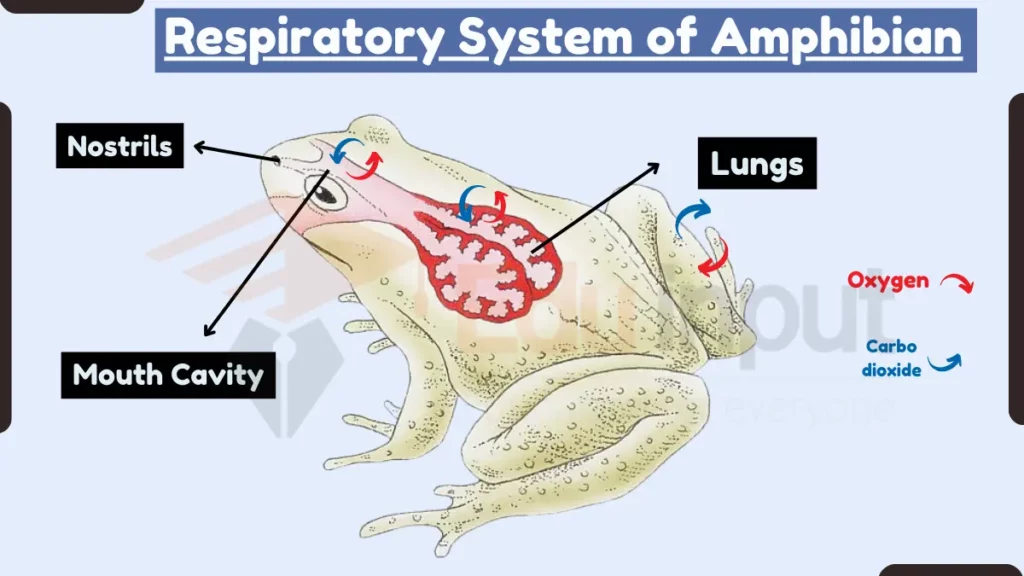Respiratory System of Amphibians – Organs, Adaptations, and Operating Mechanism
Amphibians are a class of vertebrates that live both in water and on land. The respiratory system of amphibians is unique because they utilize different organs for gas exchange depending on their life stage and habitat.
They undergo metamorphosis from larvae that breathe through gills to adults that breathe through lungs and skin.

Also Read About Amphibian Ear
Respiratory Organs in Amphibians
Here are a few organs involved in Respiratory System of Amphibians:
1. Gills
The larvae of aquatic amphibians, such as frogs and salamanders, breathe through external gills. Gills are feather-like projections that extract oxygen from water as it passes over them.
They are located on the sides of the head and neck. Gills allow amphibian larvae to remain underwater and obtain oxygen while they grow.
2. Lungs
As amphibians transition from larvae to terrestrial adults during metamorphosis, their gills are replaced by lungs. Lungs provide a larger surface area for gas exchange. Air is brought into the lungs through the mouth and nostrils.
The walls of the lungs are thin and permeable, allowing oxygen to diffuse into blood vessels. Lungs enable adult amphibians to breathe air.
3. Skin
Both larval and adult amphibians use their skin as a respiratory organ. Their skin is moist and contains many blood vessels close to the surface. Oxygen can pass through the skin into the bloodstream.
An amphibian’s skin accounts for up to half of their oxygen uptake. Cutaneous respiration allows them to supplement lung and gill breathing.
Respiration in Aquatic Amphibians
Aquatic amphibian larvae like tadpoles rely mostly on gills and their skin to obtain oxygen while submerged. Blood circulates through the fine filaments of the external gills, allowing oxygen to be absorbed.
The thin skin is also well-vascularized and facilitates cutaneous gas exchange. Together, the gills and skin provide sufficient oxygen for larvae to grow underwater.
Respiration in Terrestrial Amphibians
As amphibians mature into air-breathing adults, lungs develop to facilitate respiration on land. Lungs provide a larger surface area and better diffusion of oxygen than gills. The walls of amphibian lungs are thin and permeable. Air flows in and out through the nostrils.
In addition to lungs, the moist skin of terrestrial amphibians allows them to continue cutaneous respiration. This dual respiratory system enables gas exchange in both water and air.
Adaptations for Respiration Aquatic and Terrestrial Environments
Amphibians have made several adaptations to their respiratory system to facilitate gas exchange in both water and air. These adaptations include:
1. Spongy lungs
The lungs of amphibians are spongier than those of mammals. This increases the surface area for gas exchange, which is essential for breathing air.
2. Skin folds
Some amphibians have skin folds that increase the surface area of their skin and facilitate cutaneous respiration.
3. Buccal pumping
Amphibians can use their buccal muscles to pump air into their lungs, even when their mouths are closed. This allows them to breathe while underwater.
How Respiratory System of Amphibians Work?
Here is the pathway of the respiratory system in amphibians in bullet points:
Inhalation
- Air enters the body through the nostrils.
- Air passes through the nasal cavity, where it is warmed and humidified.
- Air travels down the pharynx, which is a tube that leads to both the esophagus and the larynx.
- The larynx, also known as the voice box, contains the vocal cords.
- Air travels down the trachea, which is a tube that leads to the lungs.
- The trachea divides into two bronchi, one for each lung.
- The bronchi branch into smaller and smaller passages called bronchioles.
- The bronchioles terminate in clusters of tiny air sacs called alveoli.
- Gas exchange occurs between the air in the alveoli and the blood in the surrounding capillaries.
Exhalation
- Air flows back through the bronchioles, bronchi, and trachea.
- Air exits the body through the nostrils.
Also Read:



Leave a Reply